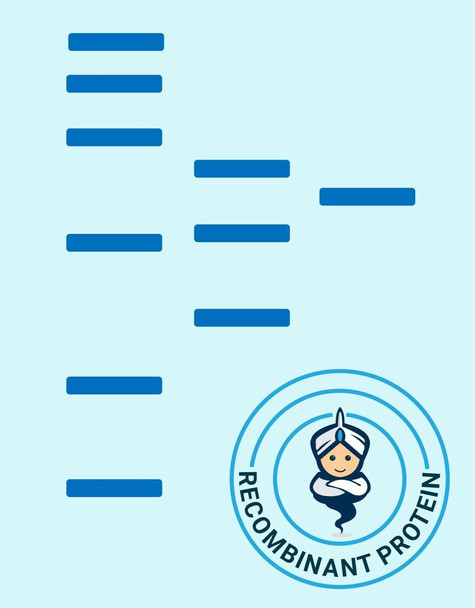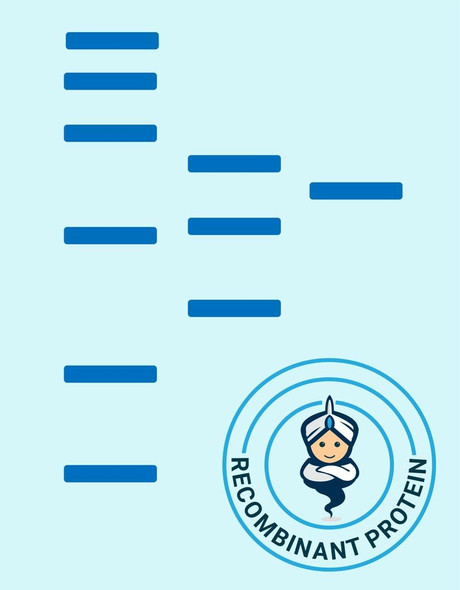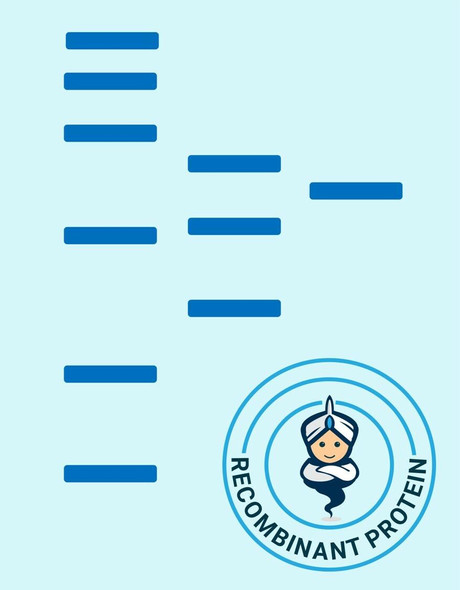Human CITED2 Recombinant Protein (RPPB3189)
- SKU:
- RPPB3189
- Product Type:
- Recombinant Protein
- Species:
- Human
- Uniprot:
- Q99967
Description
| Product Name: | Human CITED2 Recombinant Protein |
| Product Code: | RPPB3189 |
| Size: | 20µg |
| Species: | Human |
| Target: | CITED2 |
| Synonyms: | MRG1, P35SRJ, CIT-ED2, Cbp/p300-interacting transactivator 2, MSG-related protein 1, MRG-1, CITED2. |
| Source: | Escherichia Coli |
| Physical Appearance: | Sterile Filtered colorless solution. |
| Formulation: | The CITED2 solution contains 20mM Tris pH-8, 1mM DTT ,0.1M NaCl & 50% glycerol. |
| Stability: | Store at 4°C if entire vial will be used within 2-4 weeks. Store, frozen at -20°C for longer periods of time. For long term storage it is recommended to add a carrier protein (0.1% HSA or BSA).Avoid multiple freeze-thaw cycles. |
| Purity: | Greater than 90.0% as determined by SDS-PAGE. |
| Amino Acid Sequence: | MADHMMAMNH GRFPDGTNGL HHHPAHRMGM GQFPSPHHHQ QQQPQHAFNA LMGEHIHYGA GNMNATSGIR HAMGPGTVNG GHPPSALAPA ARFNNSQFMGPPVASQGGSL PASMQLQKLN NQYFNHHPYP HNHYMPDLHP AAGHQMNGTN QHFRDCNPKH SGGSSTPGGS GGSSTPGGSG SSSGGGAGSS NSGGGSGSGN MPASVAHVPA AMLPPNVIDT DFIDEEVLMS LVIEMGLDRI KELPELWLGQ NEFDFMTDFV CKQQPSRVSC LEHHHHHH |
CITED2 is a significant transcriptional cofactor that takes part in multiple organ development. CITED2 is a cAMP-responsive element-binding protein (CBP)/p300 interacting transcriptional modulator and a negative regulator for HIF1A through its competitive binding with HIF1A to CBP/p300. CITED2 is essential for mouse fetal liver hematopoiesis and is necessary for the appropriate formation of the hyaloid vasculature and for lens morphogenesis. CITED2 is a coactivator of HNF4alpha and necessary for liver development. CITED2 is a coactivator of PPAR-alpha and both participate in signaling cascades of hypoxic response and angiogenesis.
CITED2 Human Recombinant produced in E.Coli is a single, non-glycosylated, polypeptide chain containing 278 amino acids (1-270 a.a.) and having a molecular mass of 29.5 kDa.The CITED2 is fused to an 8 amino acid His Tag at C-terminus and purified by proprietary chromatographic techniques.
| UniProt Protein Function: | CITED2: Transcriptional coactivator of the p300/CBP-mediated trancription complex. Acts as a bridge, linking TFAP2 transcription factors and the p300/CBP transcriptional coactivator complex in order to stimulate TFAP2-mediated transcriptional activation. Positively regulates TGF-beta signaling through its association with the SMAD/p300/CBP-mediated transcriptional coactivator complex. Stimulates the peroxisome proliferator- activated receptors PPARA transcriptional activity. Enhances estrogen-dependent transactivation mediated by estrogen receptors. Acts also as a transcriptional corepressor; interferes with the binding of the transcription factors HIF1A or STAT2 and the p300/CBP transcriptional coactivator complex. Participates in sex determination and early gonad development by stimulating transcription activation of SRY. Plays a role in controlling left- right patterning during embryogenesis; potentiates transcriptional activation of NODAL-mediated gene transcription in the left lateral plate mesoderm (LPM). Plays an essential role in differentiation of the adrenal cortex from the adrenogonadal primordium (AGP); stimulates WT1-mediated transcription activation thereby up-regulating the nuclear hormone receptor NR5A1 promoter activity. Associates with chromatin to the PITX2 P1 promoter region. Defects in CITED2 are a cause of ventricular septal defect type 2 (VSD2). VSD2 is a common form of congenital cardiovascular anomaly that may occur alone or in combination with other cardiac malformations. It can affect any portion of the ventricular septum, resulting in abnormal communications between the two lower chambers of the heart. Classification is based on location of the communication, such as perimembranous, inlet, outlet (infundibular), central muscular, marginal muscular, or apical muscular defect. Large defects that go unrepaired may give rise to cardiac enlargement, congestive heart failure, pulmonary hypertension, Eisenmenger's syndrome, delayed fetal brain development, arrhythmias, and even sudden cardiac death. Defects in CITED2 are a cause of atrial septal defect type 8 (ASD8). ASD8 is a congenital heart malformation characterized by incomplete closure of the wall between the atria resulting in blood flow from the left to the right atria. Belongs to the CITED family. 2 isoforms of the human protein are produced by alternative splicing. |
| UniProt Protein Details: | Protein type:Nuclear receptor co-regulator; Transcription, coactivator/corepressor; Apoptosis; Cell cycle regulation; Motility/polarity/chemotaxis Chromosomal Location of Human Ortholog: 6q23.3 Cellular Component: nuclear chromatin; cytoplasm; nucleus Molecular Function:histone acetyltransferase binding; protein binding; transcription coactivator activity; LBD domain binding; chromatin binding; transcription factor activity; transcription corepressor activity Biological Process: spleen development; transcription, DNA-dependent; heart development; positive regulation of transcription, DNA-dependent; positive regulation of transforming growth factor beta receptor signaling pathway; positive regulation of cell cycle; negative regulation of transcription from RNA polymerase II promoter; liver development; sex determination; cell proliferation; response to estrogen stimulus; positive regulation of cell-cell adhesion; response to hypoxia; positive regulation of transcription from RNA polymerase II promoter; negative regulation of transcription, DNA-dependent; cell differentiation; determination of left/right symmetry; negative regulation of cell migration; negative regulation of apoptosis Disease: Atrial Septal Defect 8; Ventricular Septal Defect 2 |
| NCBI Summary: | The protein encoded by this gene inhibits transactivation of HIF1A-induced genes by competing with binding of hypoxia-inducible factor 1-alpha to p300-CH1. Mutations in this gene are a cause of cardiac septal defects. Alternatively spliced transcript variants encoding multiple isoforms have been observed for this gene. [provided by RefSeq, May 2012] |
| UniProt Code: | Q99967 |
| NCBI GenInfo Identifier: | 21542403 |
| NCBI Gene ID: | 10370 |
| NCBI Accession: | Q99967.2 |
| UniProt Secondary Accession: | Q99967,O95426, Q5VTF4, |
| UniProt Related Accession: | Q99967 |
| Molecular Weight: | 23,732 Da |
| NCBI Full Name: | Cbp/p300-interacting transactivator 2 |
| NCBI Synonym Full Names: | Cbp/p300-interacting transactivator, with Glu/Asp-rich carboxy-terminal domain, 2 |
| NCBI Official Symbol: | CITED2�� |
| NCBI Official Synonym Symbols: | ASD8; MRG1; VSD2; MRG-1; P35SRJ�� |
| NCBI Protein Information: | cbp/p300-interacting transactivator 2; MSG1-related gene 1; MSG-related protein 1; melanocyte-specific gene 1-related gene 1 |
| UniProt Protein Name: | Cbp/p300-interacting transactivator 2 |
| UniProt Synonym Protein Names: | MSG-related protein 1; MRG-1; P35srj |
| Protein Family: | Cbp/p300-interacting transactivator |
| UniProt Gene Name: | CITED2�� |
| UniProt Entry Name: | CITE2_HUMAN |










